We unload ourselves out of the bus and our tour leader Shivani is sucked into the night and immediately surrounded by a clutch of bright-eyed porters. The haggling is vigorous and a deal takes about five minutes to strike. The backpacks are loaded onto a cart and we trek into the labyrinth that is Old Delhi train station. We pass families and piles of household possessions and eventually find our own resting place at the far end of platform 16.
It is Christmas Eve and, appropriately, a nearby family have their baby son wearing a red Santa hat. His name is Bragun and he has the poppiest, most startled eyes I have seen on a baby. His grandfather is so proud showing his boggle-eyed grandson off, but nothing moves this baby elf to smile; he is much too astounded by everything he sees.
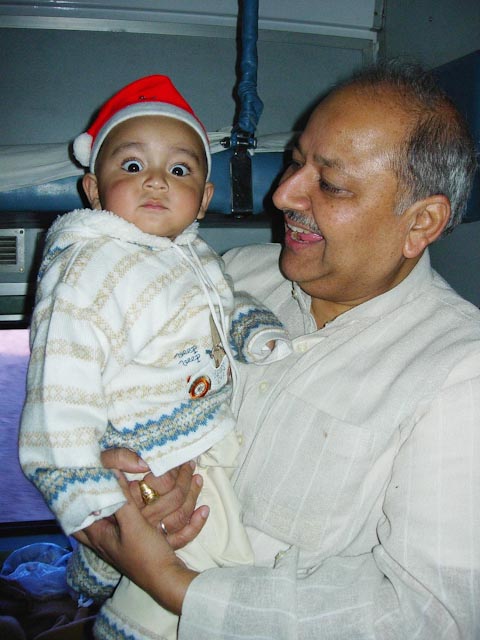
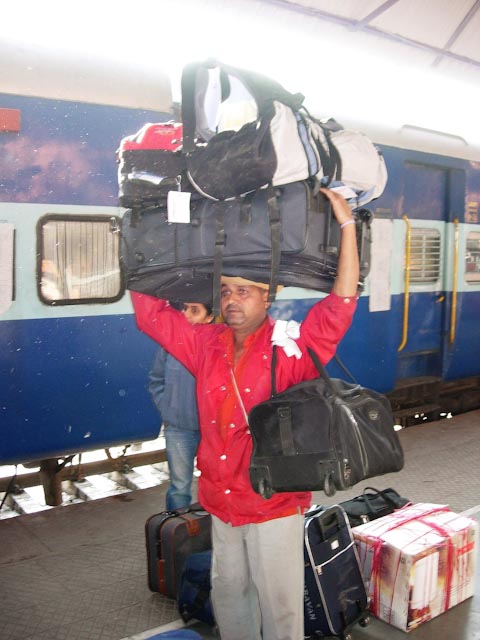
The next morning we unpeel our bleary eyes to see pale morning on the platform at Jodhpur. We are greeted by more porters who commence the challenging game of seeing how many bags they can walk off with. The winner appears to be a man who starts by balancing one large suitcase on his head. A fellow porter hoiks up one narrow backpack, and then another to rest alongside; he then helpfully slings yet another bag over this man's shoulder. This human camel does not bat an eyelid; his calves do not tremble, nor does his posture waiver. I nervously follow him as he maintains an even measured pace up the steps that take us over the platform, watching as he navigates patiently around the hoards of wild schoolchildren frenetically bouncing around. One false move I think...but all is serene.
By lunchtime we have arrived at the village of Chandelao where we will be staying in the old fort, or garh. We are welcomed by elegant orange and red turbaned gentleman dressed in brown kurta and white dhotis. They also sport the trim and elegant moustaches that make these men appear so distinguished. The finishing touch to their uniform is their pointy-toed juti slippers. Beyond French doors our rooms are appointed with 300-year-old teak furniture and the marble floor is adorned with rich coloured kilims, as well as soft glowing squares of purple, blue, green and yellow light courtesy of the stained glass windows.
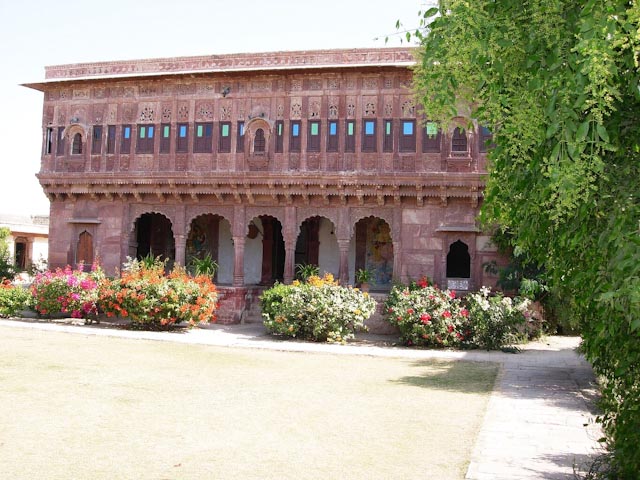
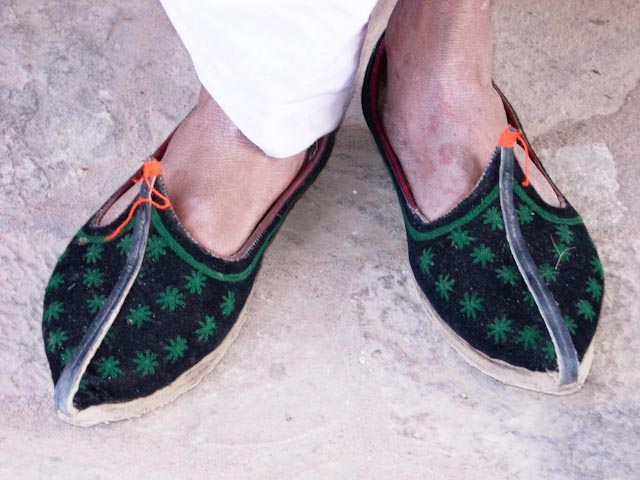
Chandelao garh's central building was built in 1744. At the beginning of the 20th century the front gate was enlarged to accommodate a man sitting in a howdah on top of an elephant. My room, Nagar Khana, was the original storage place for the ceremonial drums. The Kiwi sisters Fay and Doreen have been given the old spice room next door.
Right now I am carefully wrapping my sarong around my head and shoulders in preparation for our dusty jeep safari. To complete the Jackie-O look I don sunglasses. I join the other Jackie-Os outside and we meet our driver.
'My name is Harshvardhan,' he says extending his hand. 'You can call me Harsh...or Lovey. This is my nickname.'
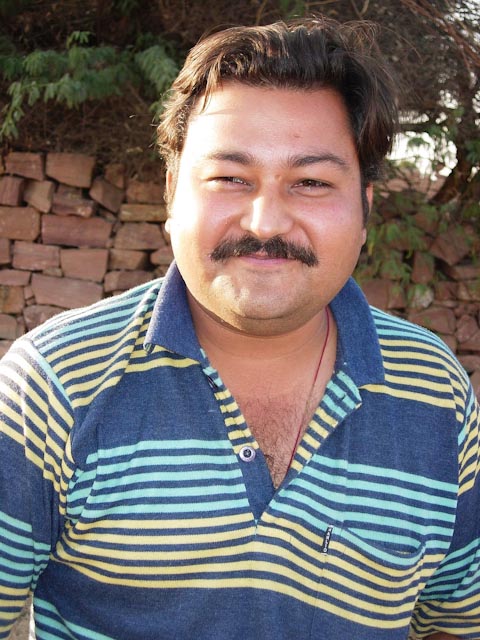
He certainly is a 'lovey' with his slick Leonardo di Caprio ’do, sideburns, his round moon shaped face and regulatory facial hair which hovers above his brilliant smile. Lovey's family own this fort and he helps with running the place. He is a garam marsala of old and new style: he wears a striped polo shirt and jeans and sneakers, but he wears the traditional gold and ruby studs in each ear as well as a heavy silver bangle and red thread around his wrist. Lovey, like Shivani, is of the Rajput caste. This is one of the higher castes and is also known as the warrior class.
We tear off in a storm of dust, careful to drive around a dozy dog without the energy to move for us, and very soon we are winding down rutted dirt roads past sparse scrubland dotted with acacia shrubs. At one point Lovey pulls over to clear the road of a branch of this evil spiny plant.
'These give punctures,' he explained. 'Already no spare tyre. We must get it fixed.'
Oh. That's comforting. How far out did you say we were going?
Lovey is a popular man judging by the number of times his phone rings and he happily yaks and drives. At one point he hangs up and says 'That was my mother. I haven't seen her for four months. She wanted to know where I am.'
I grin at him from the adjacent passenger seat. 'Did you tell her you are driving along with a truck full of women?'
He looks at me in surprise and laughs loudly, leaning from side to side out of the jeep’s open doorway. 'That is exactly what I am telling her!'
Lovey stops to point out the deer indigenous to the area. The males have black stripes and long elongated twisted antlers. 'My ancestors would have hunted the Black Buck, but now they are protected.'
We pass many people going about their business and the women are always dressed in glorious coloured saris. Even when they are performing the task of road building. The women carry baskets of pink Jodhpur sandstone on their heads and manage to make their manual labour appear most elegant. Children everywhere pour out of houses and over hills to wave excitedly and yell hello at us. We are beginning to take our new-found celebrity for granted. All of the boys as well as the girls have their ears pierced and wear the traditional loong. The mothers also line the babies' eyes with kohl in the belief that it keeps away the evil eye. One more thing they all have in common: they love having their photo taken.
We drop into the home of a potter and watch him throw pots on his wheel. The pots are bulbously round and are used for carrying water. Outside, the white, fired pots are stacked up like bubbles in a bath. The wheel itself is in a hole in the ground and the potter squats in front of it and spins it manually with a stick. When he has achieved enough speed he starts moulding and squelching the clay with his long brown fingers. Surprisingly, the wheel spins long enough for two jars or three dishes.
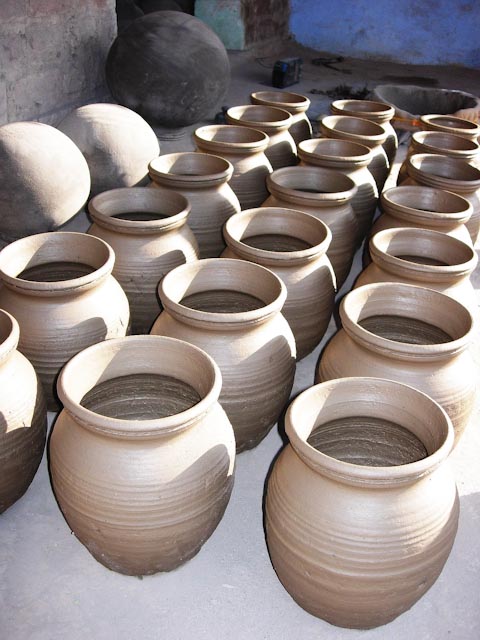
After this, we visit the home of Mr Bagharam and his wife Hella. They are of the local Bishnoi tribe and Bagharamgi has invited us to partake in an opium tea making ceremony. In a traditional ceremony the tea is slurped from the palm of the server's hand. This tea was consumed before battle as it was helpful in the case of incurring wounds; it helped staunch the blood flow as well as ease the pain. Shivani assures us no seeds are used in the tea preparation and we will feel no strange effects (dang!).
Hella Devi, Mrs Bagharam, is very welcoming and smiles a lot behind the large gold padlock-like jewellery that hangs from her nose. She obliges us by lifting her head dress to reveal a gold bauble that hangs at the top of her forehead, and then her sari hem also, to show off two solid silver leg irons around her ankles. This jewellery is handed down through families and is worn on the occasion of marriage and never removed thereafter. Hmm. Padlocks and leg irons for married women...they’re straightforward communicators, I’ll give them that.
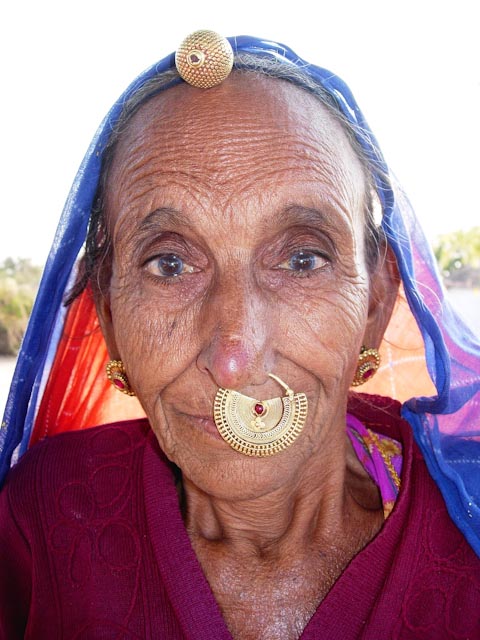
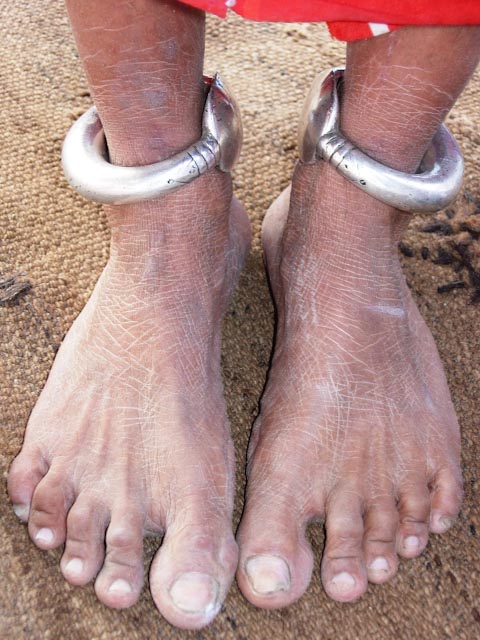
Afterwards, driving along, a curious Rachelle asks Lovey 'Who makes this jewellery?'
Lovey thinks for a second or two and pronounces 'A jewellery man!' Lovey looks like he will tip out of the jeep laughing at his own joke.
'We are warriors. We know how to pick up a sword and make war. We're not jewellery makers.'
It seems somehow appropriate that these desert warriors lie between Pakistan and the rest of India.
Later, Lovey is pointing out to us a tree with plentiful narrow dark green leaves. 'You know this tree?' On my negative he says 'It is a neem tree. Good for medicine and skin problems. This tree is very valuable to us.' After a sly pause he asks 'You know the botanical name of this tree?'
'Oh come on!' I exclaim. 'How come I get the hard questions, not "who makes the jewellery"?' Lovey thinks this is so hilarious I grab him to ensure the jeep keeps on track.
On the way home I catch my breath at the sight of a bright green field. 'That is wheat,' says Lovey. It has been one month since any rain but we see dams and lakes full of water and there are also tanks where water is kept for animals.
We pass women with large bundles of sticks balanced on their heads, their posture erect and their gait graceful. The glowing afternoon light shows off their bright pink and orange saris to perfection. A tractor laden with five men drives towards us and we marvel at the monstrous buttercup of straw carried behind, the hessian bulging out between the many vertical sticks holding the load together.
As the light turns dusky, a mauveness rises from the horizon and the wheat stubble turns golden and flecked in the fields. As we drive up towards the entry of the fort, the same dog is still lying flat out in the same position we left him in several hours previously. A languid raise of the head acknowledges our return.

Comments
Total Comments : ( ) You have to register to post a comment.
RECENT COMMENTS